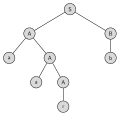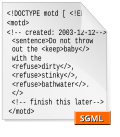An abstract syntax tree (AST) is a data structure used in computer science to represent the structure of a program or code snippet. It is a tree representation...
10 KB (1,203 words) - 21:21, 14 March 2025
in a tree structure as an abstract syntax tree. Abstract syntax, which only consists of the structure of data, is contrasted with concrete syntax, which...
4 KB (467 words) - 10:47, 17 February 2024
A parse tree or parsing tree (also known as a derivation tree or concrete syntax tree) is an ordered, rooted tree that represents the syntactic structure...
11 KB (1,359 words) - 13:08, 23 February 2025
Syntax tree may refer to: Abstract syntax tree, used in computer science Concrete syntax tree, used in linguistics This disambiguation page lists articles...
147 bytes (50 words) - 18:23, 7 May 2022
Interpreter (computing) (redirect from Abstract syntax tree interpreter)
interpret the resulting abstract syntax tree. Example data type definitions for the latter, and a toy interpreter for syntax trees obtained from C expressions...
37 KB (4,585 words) - 23:18, 7 June 2025
GNU Compiler Collection (redirect from GCC Abstract Syntax Tree)
Each front end uses a parser to produce the abstract syntax tree of a given source file. Due to the syntax tree abstraction, source files of any of the different...
55 KB (4,863 words) - 11:42, 13 May 2025
expression's subterms. An ASG is at a higher level of abstraction than an abstract syntax tree (or AST), which is used to express the syntactic structure of an...
7 KB (872 words) - 18:53, 26 December 2024
represented in memory in the form of a Concrete Syntax Tree, then transformed into an Abstract Syntax Tree. The purpose of AST Transformations is to let...
34 KB (3,367 words) - 19:23, 6 June 2025
science, a tree is a widely used abstract data type that represents a hierarchical tree structure with a set of connected nodes. Each node in the tree can be...
17 KB (2,207 words) - 10:40, 22 May 2025
higher-order abstract syntax (abbreviated HOAS) is a technique for the representation of abstract syntax trees for languages with variable binders. An abstract syntax...
9 KB (1,074 words) - 18:57, 4 January 2024
Camlp4 (section Concrete and abstract syntax)
revised syntax for OCaml, the same programming language can use different concrete syntaxes. They would all converge to an abstract syntax tree in a unique...
8 KB (1,029 words) - 22:50, 8 October 2024
programming by means of manipulating abstract syntax trees and 'splicing' results back into a program. The abstract syntax is represented using ordinary Haskell...
3 KB (231 words) - 07:42, 10 November 2024
Compiler-compiler (category Extensible syntax programming languages)
programming language as an input and performs an action or outputs an abstract syntax tree (AST). Parser generators do not handle the semantics of the AST,...
41 KB (5,129 words) - 00:57, 18 May 2025
which must be passed down from parent nodes to children nodes of the abstract syntax tree during the semantic analysis of the parsing process, are a problem...
1 KB (151 words) - 13:55, 17 September 2017
Term (logic) Context-free grammar Parse tree Abstract syntax tree Bruno R. Preiss (1998). "Expression Trees". Archived from the original on January 19...
4 KB (367 words) - 17:17, 24 February 2024
Multi-pass compiler (section Syntax analysis)
compiler is a type of compiler that processes the source code or abstract syntax tree of a program several times. This is in contrast to a one-pass compiler...
5 KB (628 words) - 14:13, 5 December 2023
input to the code generator typically consists of a parse tree or an abstract syntax tree. The tree is converted into a linear sequence of instructions, usually...
7 KB (879 words) - 15:45, 16 June 2025
parse tree, or "concrete syntax tree", which is determined by the grammar, but is generally far too detailed for practical use, and the abstract syntax tree...
20 KB (2,436 words) - 19:58, 7 June 2025
pattern matching to match pre-generated templates to parts of an abstract syntax tree (AST) or bytecode stream, and emit corresponding pre-written machine...
3 KB (293 words) - 00:00, 26 April 2025
the abstract syntax tree. As a result, attribute evaluation in L-attributed grammars can be incorporated conveniently in top-down parsing. A syntax-directed...
2 KB (243 words) - 05:50, 17 July 2020
Ravi Sethi and Jeffrey D. Ullman, its inventors, for translating abstract syntax trees into machine code that uses as few registers as possible. When generating...
6 KB (789 words) - 15:13, 24 February 2025
Attributes allow the transfer of information from anywhere in the abstract syntax tree to anywhere else, in a controlled and formal way. Each semantic function...
9 KB (1,204 words) - 00:29, 15 March 2025
are easily and efficiently implemented from the concrete syntax tree or abstract syntax tree, but editing is often more rigid than free-form text. Structure...
11 KB (997 words) - 12:48, 11 June 2025
string; it may be structured representation of code, such as an abstract syntax tree (like Lisp forms), or of special type such as code (as in Python)...
24 KB (2,948 words) - 20:35, 24 May 2025
interact with Python by translating s-expressions into Python's abstract syntax tree (AST). Hy was introduced at Python Conference (PyCon) 2013 by Paul...
6 KB (403 words) - 18:23, 23 September 2024
Nim (programming language) (section Syntax)
echo statement in the form of an abstract syntax tree as input. In this example we decided to return this syntax tree without any manipulations applied...
57 KB (5,735 words) - 19:17, 5 May 2025
notation string, also known as reverse Polish notation (RPN), or an abstract syntax tree (AST). The algorithm was invented by Edsger Dijkstra, first published...
13 KB (1,054 words) - 15:19, 22 February 2025
relies on CIL (C Intermediate Language) to generate an abstract syntax tree. The abstract syntax tree supports annotations written in ANSI/ISO C Specification...
8 KB (771 words) - 05:31, 18 May 2025
composite/tree structure that is called abstract syntax tree (see Composite pattern). The Interpreter pattern doesn't describe how to build an abstract syntax tree...
9 KB (873 words) - 00:16, 28 March 2024
SGML has an abstract syntax implemented by many possible concrete syntaxes; however, this is not the same usage as in an abstract syntax tree and as in...
32 KB (3,848 words) - 18:14, 20 February 2025












